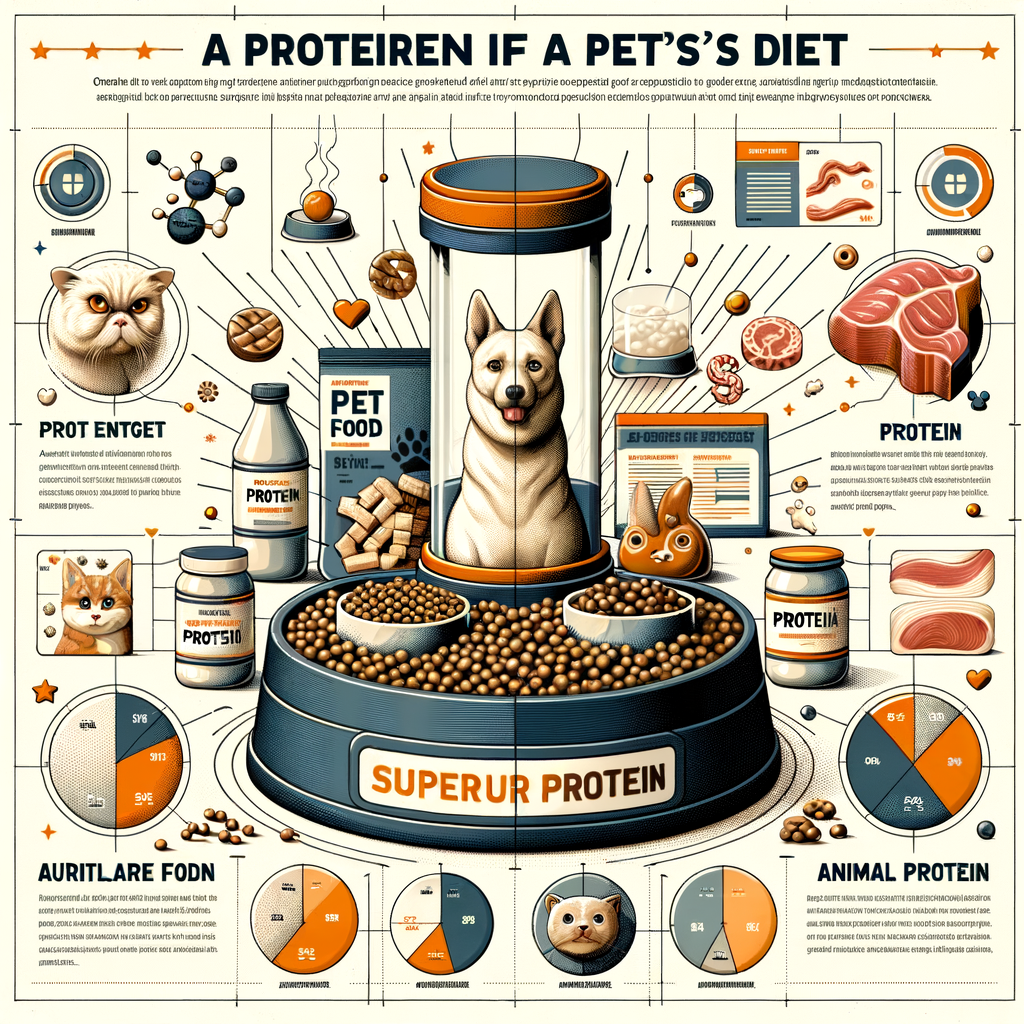
Introduction to Pet’s Protein Diet
When it comes to our furry friends, their diet plays a crucial role in their overall health and well-being. One of the key components of a balanced diet for pets is protein. But why is protein so important? Let’s delve into it.
- Understanding the importance of protein in pet’s diet
- Overview of nutritional needs of pets
Protein is an essential part of your pet’s diet. It provides the necessary building blocks for their body to grow and repair tissues. It also plays a vital role in making enzymes, hormones, and antibodies that are crucial for their health. Pets, especially dogs and cats, are primarily carnivores, meaning their bodies are designed to thrive on a diet rich in protein.
Just like humans, pets require a balanced diet to stay healthy. This includes a mix of proteins, carbohydrates, fats, vitamins, and minerals. Each of these nutrients plays a unique role in maintaining your pet’s health. For instance, carbohydrates provide energy, while fats are essential for skin and coat health. Vitamins and minerals, on the other hand, are necessary for various bodily functions, including bone growth and immune function.
Understanding your pet’s nutritional needs can seem daunting, but it doesn’t have to be. By providing a balanced diet that includes high-quality protein, you can help ensure your pet lives a long, healthy life. In the following sections, we will delve deeper into the topic of protein in pet diets, discussing quality protein sources, dietary requirements, and more.
Quality Protein Sources for Pets
When it comes to feeding our pets, protein plays a crucial role. It’s not just about the quantity, but the quality of protein that matters. Let’s delve into the world of animal protein in pet food.
Animal Protein in Pet Food
Animal protein is a vital component in pet food, particularly for carnivorous pets like cats and dogs. It provides essential nutrients that help in growth, development, and maintenance of overall health.
- Benefits of animal protein in pet food
- Examples of high-quality animal protein sources
Animal protein in pet food offers numerous benefits. It is rich in essential amino acids that pets need for optimal health. Animal protein also aids in muscle development and maintenance, supports a healthy immune system, and contributes to a shiny, healthy coat. Moreover, it is highly palatable, making it more appealing to pets.
High-quality animal protein sources include chicken, beef, fish, and eggs. These sources provide a complete profile of essential amino acids. Chicken is a lean source of protein that is easily digestible. Beef is rich in iron and other minerals. Fish, particularly salmon, is a great source of omega-3 fatty acids, which support heart health. Eggs are a complete protein source, containing all the essential amino acids your pet needs.
Remember, the quality of protein matters. Always look for pet food that lists a specific type of animal protein as the first ingredient, as this indicates a high-quality protein source.
Plant-Based Protein Sources
When it comes to feeding our pets, we often think of meat as the primary source of protein. However, plant-based proteins also play a significant role in a pet’s diet. Let’s delve into this topic and explore some high-quality plant-based protein sources for your pets.
- Understanding the role of plant-based proteins in pet’s diet
- Examples of high-quality plant-based protein sources
Proteins are essential for the growth and development of our pets. They are the building blocks of cells, tissues, organs, enzymes, hormones, and antibodies. Plant-based proteins, derived from sources like peas, lentils, and soy, can provide these essential nutrients.
While animal proteins are complete proteins, meaning they contain all essential amino acids, some plant proteins are not. However, by combining different plant proteins, we can provide all the necessary amino acids for our pets. It’s important to note that plant-based proteins are more sustainable and can be a good option for pets with specific dietary needs or allergies to certain animal proteins.
There are several plant-based proteins that can be beneficial for your pet. Here are a few examples:
| Plant-Based Protein | Benefits |
|---|---|
| Peas | Peas are a great source of protein and fiber, helping to maintain a healthy digestive system for your pet. |
| Lentils | Lentils provide a good amount of protein and are also rich in iron, helping to support your pet’s overall health. |
| Soy | Soy is a complete protein and can be a good alternative for pets with allergies to animal proteins. |
Remember, it’s important to consult with a veterinarian or a pet nutrition expert when changing your pet’s diet or introducing new food sources. They can provide guidance based on your pet’s specific needs and health conditions.
Dietary Requirements for Pets
Understanding the dietary needs of your pets is crucial for their health and well-being. One of the most important components of their diet is protein. Let’s delve into the protein requirements for different types of pets.
Protein Requirements for Different Pets
- Protein requirements for dogs:
- Protein requirements for cats:
- Protein requirements for birds:
- Protein requirements for small mammals:
Dogs, being omnivores, require a balanced diet that includes both plant and animal proteins. On average, adult dogs need about 18% of their diet to be protein, while puppies require around 22%. This ensures they have the necessary amino acids for growth and tissue repair.
Cats are obligate carnivores, which means they need a higher percentage of protein in their diet compared to dogs. Adult cats should have at least 26% protein in their diet, while kittens need about 30%. This helps them maintain healthy muscles and immune system.
The protein requirements for birds vary greatly depending on their species. For instance, parakeets need about 12-15% protein in their diet, while canaries require 16-20%. It’s essential to research your specific bird species to ensure they’re getting the right amount of protein.
Small mammals such as rabbits, guinea pigs, and hamsters also need protein in their diet, but in smaller amounts compared to dogs and cats. Generally, these pets need about 15-20% protein in their diet for optimal health.
Remember, the quality of protein is just as important as the quantity. Always choose high-quality, easily digestible protein sources for your pets to ensure they’re getting the most out of their diet.
Importance of a Balanced Pet Diet
Feeding your pet a balanced diet is crucial for their overall health and well-being. A key component of this diet is protein. Let’s delve into the role of protein in a balanced pet diet and the consequences of protein deficiency in pets.
- Role of Protein in a Balanced Pet Diet
- Consequences of Protein Deficiency in Pets
Protein is a vital part of a balanced pet diet. It provides essential amino acids, which are the building blocks for healthy muscles, skin, and fur. Protein also plays a significant role in the production of antibodies, which help fight off infections and diseases. A diet rich in high-quality protein can help your pet maintain a healthy weight, stay active, and live a long, healthy life.
Protein deficiency in pets can lead to a variety of health issues. These can range from minor problems like dull coat and skin issues to more serious conditions such as weight loss, muscle wastage, and weakened immune system. In severe cases, protein deficiency can even lead to organ failure. Therefore, it’s crucial to ensure your pet’s diet contains adequate amounts of protein.
In conclusion, protein is an essential part of a balanced pet diet. It’s important to understand your pet’s specific protein needs and ensure they’re getting enough from their diet. A balanced diet rich in protein can help your pet live a healthier, happier life.
High-Protein Pet Food: Pros and Cons
When it comes to feeding our pets, we all want to make sure we’re giving them the best. One option that’s been gaining popularity is high-protein pet food. But like any diet, it has its pros and cons. Let’s take a closer look.
- Benefits of High-Protein Pet Food
High-protein pet food can offer several benefits. For one, protein is essential for your pet’s growth and development. It helps build and repair body tissues, and it’s also necessary for the creation of antibodies that fight off infections.
According to a study by the National Research Council, dogs and cats require specific amounts of protein in their diets. Dogs need at least 18% of their diet to be protein, while cats require a whopping 26%. High-protein diets can easily meet these requirements.
Another benefit is that high-protein diets can help overweight pets lose weight. Protein-rich foods tend to make pets feel fuller, so they eat less and lose weight. Plus, protein helps maintain lean muscle mass during weight loss, which is healthier than losing muscle.
- Potential Risks and Considerations
While high-protein diets can offer many benefits, they aren’t without their risks. One potential concern is that too much protein can be hard on a pet’s kidneys. This is especially true for older pets or those with kidney disease.
Another consideration is that not all proteins are created equal. Some high-protein pet foods use low-quality protein sources, which aren’t as beneficial for your pet’s health. It’s important to look for high-quality protein sources, like meat, fish, and eggs.
Finally, high-protein diets can be more expensive than other types of pet food. If cost is a concern, you might need to weigh the benefits against the price.
In conclusion, high-protein pet food can offer many benefits, but it’s not right for every pet. Always consult with your vet before making any major changes to your pet’s diet.
Understanding Protein Content in Pet Food
Protein is a vital component of your pet’s diet. It helps in the growth and repair of body tissues, production of hormones and enzymes, and provides energy when needed. But how can you ensure that your pet is getting the right amount and quality of protein from their food? The answer lies in understanding pet food labels.
Reading Pet Food Labels
Reading pet food labels can seem like a daunting task with all the numbers and technical terms. However, with a little knowledge and practice, you can become proficient at it. Here are some key points to focus on:
- How to identify high-quality protein sources on pet food labels
- Understanding the percentage of protein content in pet food
High-quality protein sources are those that provide all the essential amino acids your pet needs. These are usually named meat sources like chicken, beef, or fish. If the label lists ‘meat’ or ‘poultry’ without specifying the type, it may not be a high-quality protein source. Also, look for the term ‘meal’ after the meat source, like ‘chicken meal’. This means the water has been removed from the meat, making it a concentrated source of protein.
The percentage of protein content is usually listed under ‘Crude Protein’ on the label. This number tells you the amount of protein in the food on a dry matter basis. For adult dogs, a protein content of 18-25% is generally recommended, while for cats, it’s around 26-30%. However, these numbers can vary depending on the pet’s age, breed, and health condition. Always consult with your vet to determine the right protein level for your pet.
Understanding protein content in pet food is crucial for your pet’s health and well-being. By learning to read pet food labels, you can ensure your furry friend is getting the right amount and quality of protein they need to thrive.
Case Studies: Impact of Protein on Pet Health
Protein is a vital nutrient for our pets. It helps them grow, repair tissues, and maintain a healthy immune system. But what happens when our pets get too much or too little protein? Let’s explore two case studies that highlight the impact of protein on pet health.
-
Case Study 1: Impact of High-Protein Diet on a Dog’s Health
Meet Max, a three-year-old Golden Retriever. Max’s owner, Sarah, decided to switch Max to a high-protein diet after reading about its benefits. After a few months, Sarah noticed some changes in Max’s behavior and health.
Max had more energy and his coat was shinier than ever. However, he also started drinking a lot more water and urinating more frequently. A visit to the vet revealed that Max had developed kidney issues due to the high-protein diet. The vet explained that while dogs need protein, too much of it can put a strain on their kidneys.
After adjusting Max’s diet, his kidney function improved. This case study shows that while protein is essential for dogs, it’s important to balance their diet to avoid health issues.
-
Case Study 2: Recovery of a Cat from Protein Deficiency
Next, let’s talk about Bella, a one-year-old Persian cat. Bella’s owner, John, was feeding her a homemade diet that was low in protein. Over time, Bella became lethargic and lost weight. She also had a dull coat and seemed to get sick often.
John took Bella to the vet, who diagnosed her with protein deficiency. The vet explained that cats are obligate carnivores, which means they need a high amount of protein in their diet. John started feeding Bella a balanced diet with enough protein, and Bella’s health improved dramatically. She gained weight, her coat became shiny, and she was more active.
This case study highlights the importance of providing our pets with the right amount of protein. Not enough protein can lead to health issues, just like too much protein can.
In conclusion, protein plays a crucial role in our pets’ health. It’s important to provide them with a balanced diet that meets their protein needs. Always consult with a vet before making significant changes to your pet’s diet.
Conclusion: Powering Your Pet with Protein
As we reach the end of our exploration into the world of pet nutrition, we can confidently say that protein plays a vital role in your pet’s diet. Let’s take a moment to recap the key points and takeaways to ensure your pet gets the best nutrition possible.
- Recap of the importance of protein in pet’s diet:
- Key takeaways for pet owners:
- Protein is an essential part of your pet’s diet and should make up a significant portion of their daily food intake.
- Not all proteins are created equal. Ensure your pet’s food contains high-quality protein sources.
- While high-protein diets can have many benefits, they may not be suitable for all pets. Always consult with your vet before making significant changes to your pet’s diet.
- Understanding the protein content in pet food can be tricky. Look for the ‘guaranteed analysis’ on the pet food label to get a clear idea of the protein content.
- Protein’s impact on pet health is undeniable. As seen in our case studies, a balanced protein diet can lead to improved health and vitality in pets.
Protein is the building block of your pet’s body. It helps in the growth and repair of muscles, tissues, and organs. It also plays a crucial role in the production of hormones and enzymes that are essential for your pet’s overall health. High-quality protein sources, such as chicken, beef, fish, and eggs, provide your pet with essential amino acids that they can’t produce on their own.
In conclusion, powering your pet with protein is not just about feeding them more meat. It’s about providing a balanced diet that includes the right amount and type of protein. Remember, every pet is unique, and their dietary needs may vary. Always consult with a professional before making any significant changes to your pet’s diet.






